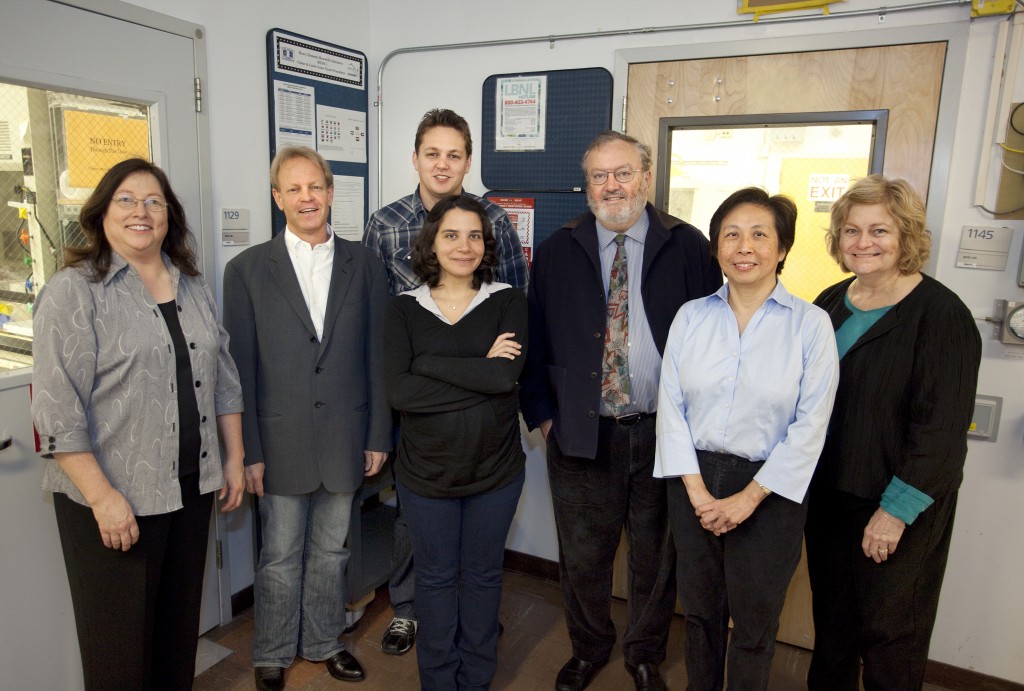Lawrence Berkeley National Laboratory has been awarded $12.8 million in American Recovery and Reinvestment Act funding by the National Institutes of Health (NIH) for research into cancer, neurodegenerative diseases, radioactive decontamination and a variety of other health conditions.
The grants bring Berkeley Lab’s total Recovery Act funding to more than $240 million in areas covering energy, computing and general science, as well as infrastructure projects. The NIH grants will go to 14 individual research projects ranging from disease investigation to the development of tools for medical researchers.
“The Recovery Act grants from NIH have allowed us to create quite a few new positions for scientists, technicians, research associates and postdoctoral fellows, as well as retain some jobs,” said Joe Gray, Associate Laboratory Director for Life Sciences. “We’re helping to train the nation’s next generation of scientists while also doing important research in critical areas of human health that we may not have been able to do without these funds.”
The largest individual award is $4.2 million for a two-year research project to develop treatments for contamination by radioactive actinide particles, such as those from fallout from a nuclear accident or a so-called “dirty bomb.” Berkeley Lab’s Glenn T. Seaborg Center (GTSC) has been working for years on oral therapeutics to treat internal actinide contamination, and this work has taken on more urgency in recent years as threats of nuclear terrorism have become more plausible. Previously, the main at-risk population had been nuclear power plant and defense workers.
The only existing method of mitigating risks of actinide contamination is a treatment developed in the 1950s that must be given through an injection, which would not be viable in a situation where residents of an entire metropolitan area must be injected in a matter of hours. Further, this agent, known as DTPA, is effective only on a few actinides.

Berkeley Lab scientists working on the actinide decontamination project are (left to right) Kathy Bjornstad, David Shuh, Chris Rosen, Rebecca Abergel, Kenneth Raymond (group lead), Polly Chang and Eleanor Blakely.
Two molecules that have been developed at Berkeley Lab to sequester actinides can target a much wider range of actinides, the most well-known of which are uranium and plutonium. Contamination can cause acute cellular and tissue damage leading to cancer. Berkeley Lab’s compounds would help excrete up to 90 percent of the radioactive particles within 24 hours, and given doses over subsequent days, nearly complete excretion is possible, the researchers say.
“The ARRA funding will enable us to proceed with pre-clinical development of two compounds that have been designed and tested,” says scientist Rebecca Abergel. “They are very promising. We have not observed major toxicity issues, and the efficacy is in the range we want it to be. What we want to accomplish in the next two years is to gather data to get approval from the Food and Drug Administration.”
The Berkeley Lab research group, led by GTSC Director Kenneth Raymond, will partner with SRI International and the Lovelace Respiratory Research Institute to conduct testing, including toxicology and pharmacology tests, with the goal of filing an investigational new drug application with the FDA in two years.
Other Recovery Act awards to Berkeley Lab from NIH include:
- $1.4 million to better understand a molecular switch in RNA splicing that occurs in red cell precursors. Understanding RNA splicing is important because proper splicing is essential for normal development; conversely, aberrant splicing is a common cause of genetic disease and a factor in many human cancers. The principal investigator (PI) is John Conboy.
- $1 million to develop tools to better understand the role of mitochondrial dysfunction in neurodegenerative diseases, including Alzheimer’s disease, Parkinson’s disease, and Huntington’s disease, which together afflict at least one out of every 50 Americans. These three diseases share the property that mitochondria are not keeping up with the energy demands of the cell. The PIs are Cynthia McMurray and Trent Northen.
- $861,034 to investigate how red blood cell production is increased in response to multiple inherited and acquired anemias, including thalassemia, sickle cell disease, hereditary membrane disorders, autoimmune red blood cell destruction, and blood loss. The PI is Joel Chasis.
- $842,908 to develop a model to uncover the mechanism by which a certain noncoding region of the human genome confers susceptibility to cardiovascular or coronary artery disease, one of the major causes of mortality in the U.S. and the developed world. Researchers in the Genomics Division have identified a strong link between a noncoding region of the human genome and susceptibility to CAD. The PI is Len Pennacchio.
- $783,397 to complete a four-year project to map chromosomal proteins in the genome of the fruit flies. This project is highly likely to provide information critical to understanding the roles of chromatin in human cells and diseases, including cancer. The PI is Gary Karpen.
- $433,476 to build a next-generation robotic system for the study of biological molecules and their assemblies. The PI is Thomas Earnest.
- $366,123 to accelerate the development of the PHENIX software program, which automates crystallography data analysis, and the process of understanding the three-dimensional structure of proteins and nucleic acids. The PI is Paul Adams.
- $325,975 to investigate the roles of the SATB1 protein in the progression of different types of cancer and proteins functionally related to SATB1 in self-renewal and differentiation of embryonic stem cells. The PI is Terumi Kohwi-Shigematsu.
- $278,332 for the Berkeley Cancer Genome Center to systematically analyze the transcriptomes of human brain, ovarian and lung cancer with emphasis on discovering alternately spliced genes. This effort contributes to The Cancer Genome Atlas project. The PI is Joe Gray.
Berkeley Lab is a U.S. Department of Energy national laboratory located in Berkeley, California. It conducts unclassified scientific research for DOE’s Office of Science and is managed by the University of California. Visit our website at http://www.lbl.gov.
Additional information: